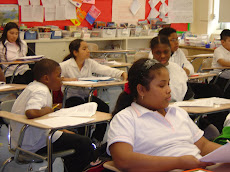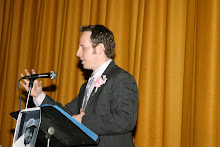Happy New Year! I hope everyone is looking forward to returning as much as I am. With the last couple of months enduring so many changes, we did a tremendous job holding our school together. I am excited to move back into the planning and preparing mode rather than the stabilizing mode. When students encounter so many changes with personnel, schedules, discipline codes, expectations, and more, it makes our job even more challenging to establish consistency and allow our routines and procedures to assist us in moving instruction toward our goals. Without our base to address discipline and reduce interruptions, it makes teaching nearly impossible.
The great news is we have very little to face for the rest of the year. It can only get easier from this point on compared to what has been endured for the last two months. The Organizational Cabinet will continue to develop a plan to build a stronger and more productive culture within the 7th grade. We have collected the areas identified as needing support and now it is just a matter of time to put together a plan with accountable and fair deadlines. The main goal of the plan will be to unite efforts to rebuild our approach so that classroom instruction can become the focus of our students and staff. The key is ALL staff working together which includes administration, counselors, school aides, and teachers. I am truly confident that we will be successful in whatever plan is finalized in Cabinet and approved by the 7th grade team. It will not be easy, as all initiatives will require an increase of effort from many people. This will be needed until stabilization is achieved. From there, we can move back to the planning cycle rather than the reacting methods we have been dependent on for the last month and a half.
Break flew by for me but I was able to invest some my free time to read some literature on the “Higher Level Thinking” focus that administration has decided on. I thought my knowledge of Bloom’s Taxonomy was stronger than in reality. I read a good chunk of the book “Asking Better Questions” by Norah Morgan and Juliana Saxton. So far, the book has been very helpful in reminding me how much the classroom is a stage for us and our students. As the star of the show, I have to find a way to engage my audience and maintain their attention. If I feel them slipping away, I have to adjust what I am doing to keep their eyes on me or at least focused on what we are doing. If conversation begins developing in my audience, it is a clear indication that I have lost their interest. It is from that moment, a decision needs to be made. Pushing forward with what I am doing will only result in the same outcome unless some sort of climatic point is about to be reached. If I believe the nearby moment will happen fast enough, I can push forward and hope it has enough of an impact to bring them back or I can abort and figure out another way to reach that moment. For instance, when there are only three more minutes of a mini-lesson, then I know I need to finish. After, most of the time, I will break the students into groups with a more engaging activity. The duties of keeping their attention! I could bring them back with a comment such as, “Give me three more minutes and then, I promise you, you will like what we are doing next.” I could also add a British accent to what I am saying and see if any of them notice. Maybe, I could tell them all NOT to pay attention to what I am saying to see if they actually become curious. Finally, I could ask a question of controversy related to my topic to see if they begin thinking about what I am saying and become curious. Either way, I want them to desire to know what I am talking about.
That is the key to a great lesson. It is not maintaining the discipline in the classroom to cover material. It is sparking curiosity and interest so they become engaged with what you are teaching. Together, you explore the content. It is not an easy task to do, but when it is achieved, it is the best time ever. The book I am reading says there is a moment you can tell when the students are engaged. They make eye contact on their own. They make verbal or non-verbal responses in a supportive and congruent manner (silence is not necessarily a measurement). The two easiest ways to tap into their interest is to make the content relevant to them or connected to their interests. Both methods access their curiosity which is the core needed to expand on engagement and commitment so they will eventually move forward with internalizing, interpreting, and evaluating the content. “Effective teaching requires more than knowing what you are going to teach, why you are teaching it, and to whom you are teaching it. It means recognizing that all students bring their feelings, as well as their minds and bodies, into the classroom. Understanding how you can engage and capitalize on this internal state of needs, preferences, anxieties, curiosity, and excitement will be the dynamic that transforms the classroom into a place where learning is recognized by the students as something to be valued for itself rather than as a means to someone else’s evaluation.” (Morgan and Saxton, 2006,p. 31).
As we continue to strengthen our routines and procedures to manage our classroom, we also need to explore how to move our instruction. Higher level thinking and our use of questioning will be useful tools in developing student interest to promote engaging work within our classrooms. Our stage is setup, now it is time to put on a show that we know our students will want to watch.
Staff Birthday
Gabriela Vargas Jan. 15th
Quote of the Week
“Unless the question holds the possibility of an answer with personal meaning for the student, there can be no change in understanding. The more you know about students’ backgrounds, interests, and experiences, the greater chance you have of choosing a question that holds that possibility.”
–Norah Morgan and Juliana Saxton
What is the research telling us?
Examples of Promoting Higher Level Thinking
http://teaching.uncc.edu/resources/best-practice-articles/instructional-methods/promoting-higher-thinking
The following article was taken from the website:
http://www.edarticle.com/differentiated-learning/higher-level-thinking-as-easy-as-a-question.html
Higher Level Thinking? As Easy As A Question
By Michael Michels
“Questions, I’ve got some questions” is how a Jack Johnson song from the Curious George Soundtrack begins. From the beginning of our lives, we are always questioning something. They start as simple things at first as we explore our new, vast world and the complexity grows as we mature. One of the most amazing faculties afforded to us as humans is the ability to think. The problem for teachers is how to get our students to utilize this amazing skill to the best of their abilities. We all know that students who are constantly involved in the learning process will thrive and grow the most academically.
So, here is the situation. Questions are being asked all day and every day in schools, offices, homes and elsewhere around the world. But, what kinds of questions? Do they always work? Do we get the answer we were looking for? Are our students engaged in the learning process? Do we use questioning enough? You can figure out the answer for your specific instance very easily.
Think about your daily lesson, work or social life. If you just completed a project in class with your students, do you ask, “What did you think about the project?”. You will most likely hear lots of “Yes’s.” and “It was OK.” and responses like that. These are short answers that make students feel like they are appeasing you.
Imagine being at work and asking your employees or co-workers, “How did you think the meeting went?”. Again, you will hear quick responses that have little to no thought involved in them. This will happen for a variety of reasons.
The same thing will happen with friends, family and basically any other situation you are in. Sometimes we hear people talking about “digging deeper” to find out more information about something. What does “digging deeper” really mean? It means, asking the right question.
When trying to elicit a response from anyone, we need to use the proper start to every question. Simply asking “How was your trip?” will never work. The answer could just be “Good.”. Not exactly what you were looking for if you plan to take a similar trip to the same location. You need to get more information. The question starter “How was….?” was very insufficient in promoting conversation. Promoting conversation is the key to making the mind think. Simply asking, “How could you summarize your trip to…?” would work better. This person would then describe and explain the major parts of the trip and you can guide the conversation in the direction of your curiosity.
How does this relate to the classroom? In the classroom this means that the student has to think about prior learning and come up with an organized response to the question. Higher-level thinking questions do just that. They do not allow for one-word or short answers. The student must become engaged in a conversation. This may mean that they are interpreting data, defending an opinion, coming up with a solution to an issue or any other variety of responses that cause students speak their thoughts aloud.
Now, how is this done? Higher-level thinking questions have beginnings that are well defined. They automatically cause individuals to “ponder”. Many times they will relate to opinions that individuals may have formed so that they want to express themselves. Here are some examples of question starters: “How can you explain why…?”, “How would you compare…?”, “In your owns words, what is…?”, “How could you simplify…?”, “What is the significance of…?” (Kagan, 1999). Right away you can see how the gears start working and the process of being involved begins. Students, or anyone for that matter, begin to think! When you get immersed in it, you can have the students use the “starters” to come up with questions regarding a topic. Again, making them a part of the experience keeps that involvement at a high level.
We have all heard of the value of good questions somewhere in our lives. Dr. Spencer Kagan has developed sets of these “question starters” along with entire books devoted to specific topic areas. This way of thinking and teaching stresses the development of thinking skills along with higher-level thinking, such as creative and critical thinking. By utilizing this type of questioning in you daily lessons and lives, you can help individuals to become more intellectual, creative and involved than they ever have been. Dr. Kagan has devoted his life to Cooperative Learning in the classroom and has a wealth of resources available. Check out Kagan online or search for Kagan on Amazon and see what the buzz is all about. I could say, “What are you waiting for?”, but I can make you really consider it by asking, “What differences might you see in your students if you apply this type of questioning strategy?”. Good Luck!!!
Subscribe to:
Post Comments (Atom)





No comments:
Post a Comment